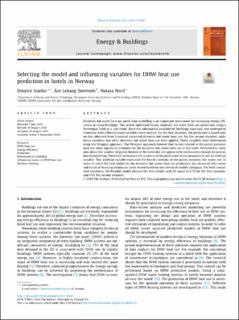| dc.contributor.author | Ivanko, Dmytro | |
| dc.contributor.author | Sørensen, Åse Lekang | |
| dc.contributor.author | Nord, Natasa | |
| dc.date.accessioned | 2020-10-08T10:39:15Z | |
| dc.date.available | 2020-10-08T10:39:15Z | |
| dc.date.created | 2020-09-11T08:08:01Z | |
| dc.date.issued | 2020 | |
| dc.identifier.citation | Energy and Buildings. 2020, 228 . | en_US |
| dc.identifier.issn | 0378-7788 | |
| dc.identifier.uri | https://hdl.handle.net/11250/2681729 | |
| dc.description.abstract | Domestic hot water heat use prediction modelling is an important instrument for increasing energy efficiency in many buildings. This article addressed hourly domestic hot water heat use prediction, using a Norwegian hotel as a case study. Since the information available for buildings may vary, two widespread situations with different input variables were studied. For the first situation, the prediction is based only on data obtained from historical measured domestic hot water heat use. For the second situation, additional variables that affect domestic hot water heat use were applied. These variables were determined using the Wrapper approach. The Wrapper approach showed that factors related to the guests presence have the most significant influence on the domestic hot water heat use in the hotel. Nevertheless, daily data about the number of guests booked at the hotel did not appear to be informative enough for precise hourly modelling. Therefore, to improve the accuracy of the prediction, it was proposed to use an artificial variable. This artificial variable explained the hourly intensity of the guests domestic hot water use. In order to select the best model for the domestic hot water heat use prediction, ten advanced time series and machine learning techniques were tested based on the criteria of models adequacy. For both considered situations, the Prophet model showed the best results with R2 equal to 0.76 for the first situation, and 0.83 the second situation. | en_US |
| dc.language.iso | eng | en_US |
| dc.publisher | Elsevier | |
| dc.rights | CC BY 4.0 | * |
| dc.rights.uri | https://creativecommons.org/licenses/by/4.0/ | * |
| dc.subject | DHW heat use | en_US |
| dc.subject | Energy efficiency | en_US |
| dc.subject | Prediction | en_US |
| dc.subject | Mathematical modelling | en_US |
| dc.subject | Influencing factors of DHW heat use | en_US |
| dc.subject | Machine learning | en_US |
| dc.title | Selecting the model and influencing variables for DHW heat use prediction in hotels in Norway | en_US |
| dc.type | Peer reviewed | en_US |
| dc.type | Journal article | en_US |
| dc.description.version | publishedVersion | en_US |
| dc.rights.holder | © 2020 The authors | en_US |
| dc.subject.nsi | VDP::Teknologi: 500 | en_US |
| dc.source.pagenumber | 10 | en_US |
| dc.source.volume | 228 | en_US |
| dc.source.journal | Energy and Buildings | en_US |
| dc.identifier.doi | 10.1016/j.enbuild.2020.110441 | |
| dc.identifier.cristin | 1828914 | |
| dc.relation.project | Norges forskningsråd: 267635 | en_US |
| cristin.ispublished | true | |
| cristin.fulltext | original | |
| cristin.qualitycode | 2 | |

